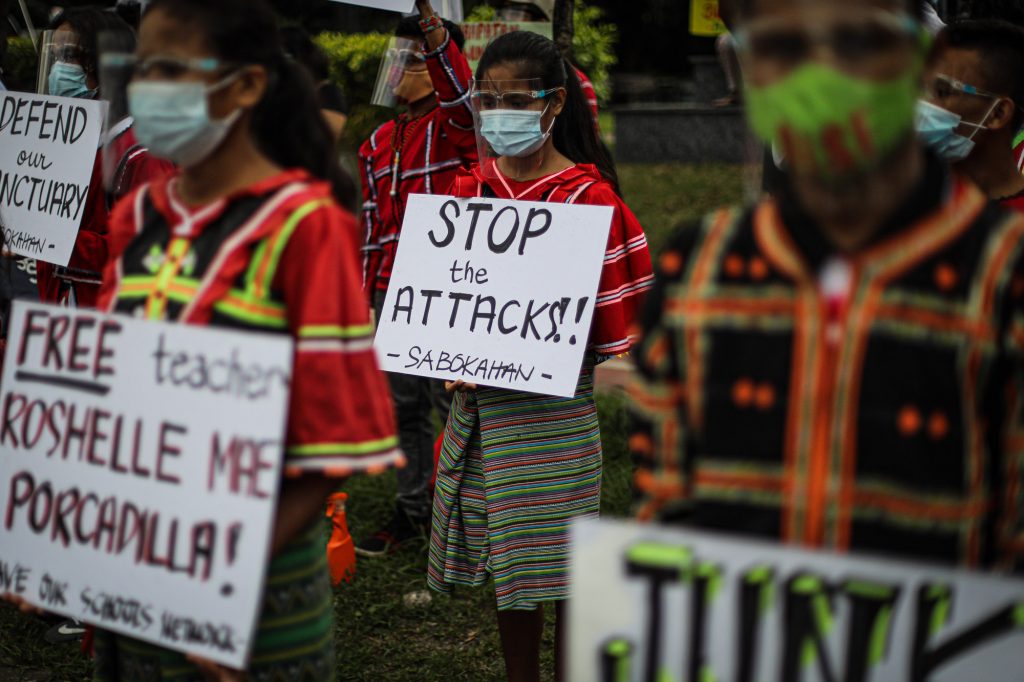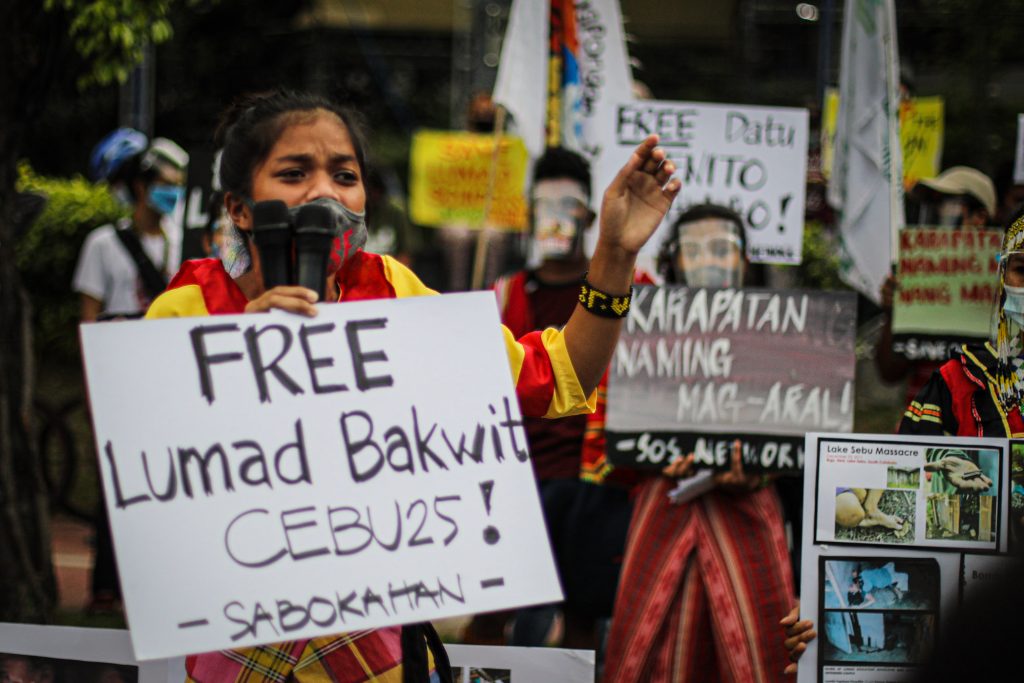Feb. 15, half-past 11 in the morning.
The sound of children screaming broke the silence shortly after police barged inside a retreat house in Cebu. The authorities claimed it was a “rescue mission”: to “save” lumad children from an alleged New People’s Army training ground supposedly located inside a religious organization’s property accessible via the University of San Carlos-Talamban Campus.
Given the police’s track-record of shift-shaping stories, their narrative demanded a lot more suspension of disbelief than all the monster movies combined.
Anyone with half the mind to get to the bottom of things would know that the lumad’s presence in a retreat house, owned by the Societas Verbi Divini (SVD) Philippines Southern Province, was part of a bakwit school program of the Archdiocese of Cebu-Commission on Social Advocacies which was launched in the first quarter of 2020.
The joint statement released by SVD Philippines Southern Province and the University of San Carlos in response to the raid clarified that “[T]he SVD hosted last March 11, 2020 the delegation of forty-two (42) students accompanied by five teachers and three community elders (Datu), after four other educational institutions in Cebu hosted the same. The delegation was housed at the SVD-owned retreat house, accessible through USC–Talamban Campus. The delegation was supposed to complete their modular schooling on April 3, 2020 after which, they would have returned to their respective indigenous communities.”
Quarantine restrictions beginning the middle of March prevented the lumad from returning to their respective homes, leaving the largely young delegation under the care of the SVD Community.
Apparently, plans have been made to return the children to their rightful homes. The logistics for their journey back home required, however, swab tests, fare and food allowance. These posed a challenge to the SVD who raised additional costs for the delegation’s unexpected yearlong stay.
“[T]he travel of the delegation was planned to be carried out in batches,” the statement said. “At least four of the delegates have so far returned to their place, and another batch was scheduled to return this week.”
The statement, signed by three heads of the religious organizations, namely SVD Southern Province Provincial Superior Fr. Rogelio N. Bag-ao, SVD President (University of San Carlos) Fr. Narciso A. Cellan Jr., and no less the Archbishop of Cebu, the Most Reverend Jose S. Palma, D.D., assures authorities that “the presence of the lumad in the retreat house was for their welfare and well-being, and all throughout, they were nurtured, cared for, and treated with their best interest in mind”.
Fifteen lumad minors and six adults were taken by elements of the Police Regional Office 7 in Cebu. We all know the lumad “bakwit” or evacuees were forced into exile due to increased militarization in the area.

The raid immediately brought me back to November 1938. The place: Nazi Germany. The event: Kristallnacht or The Night of Broken Glass. Why Kristallnacht? Because if there has been one common thread that cuts across all tyrannical governments in all of history, it is the propaganda machinery.
The lies which serve to cover up the real intention, to be more succinct.
The beginning of the Holocaust was sparked by the Nov. 7, 1938 assassination of German diplomat stationed in Paris, Ernst vom Rath, by German national Herschel Grynszpan.
Grynszpan at the time resided illegally in Paris, the child of Polish Jewish immigrants who settled in Hanover sometime 1911. The assassination, which he carried out at the age of 17, was fueled by the eviction of his parents and all the Polish Jews living within the Reich.
By then, Nazi Germany’s Führer Adolf Hitler had already risen to power and had, in fact, occupied Sudetenland a month earlier. Sudetenland comprised the German-populated frontiers of the former Czechoslavakia.
Losing no time, Nazi Minister of Propaganda, Paul Joseph Goebbels, accused the whole global Jewish community, not just Grynszpan, of conspiring to commit the assassination.
It was called “The Night of Broken Glass” due to the shards of shattered windows which littered Germany’s streets. The immediate aftermath of Kristallnacht saw Nazi Germany drafting laws which opened the doors to the eventual slaughter of the Jews.
Goebbels’ fabricated claims placed the whole Jewish community in a really bad light. Responding to the imagined threat, the Nazi government packaged itself as the “savior” who would “rescue” Germany from the clutches of the Jews.
It was all a lie. Why? Because if this section of history has taught us something, it is this: the Nazi’s “rescue of Germany” was nothing more than a cover-up for the looting of Europe, cloaked in the blood of six million Jews. It was one of the grandest heists ever recorded, approximately $19 billion worth of gold in today’s monetary value.

It’s no secret that the ancestral domains of indigenous people make up the whole gamut of reasons why the State is out to chase the lumad out of their ancestral lands. The State’s tactics hardly changed in the course of several administrations.
On July 2015, during the final months of Pres. Benigno Aquino III, roughly 500 police officers conducted a “rescue mission”—sounds familiar?—forcing several lumad at the Haran Center to return to their homes. The lumad resisted, resulting in the injury of 17 IPs and two policemen during the scuffle.
Pres. Duterte himself has not spared the lumad his threats. In 2017, at a news conference following his State of the Nation Address, Duterte threatened to bomb lumad schools. Months before the pandemic arrived, the Department of Education closed down 55 lumad schools for fear that they were using “a curriculum that had not been approved by the department”.
Tens of thousands of IPs have already been displaced, with the Save our Schools network logging a little over 220 military attacks against the lumad since 2017.
According to the Indigenous Environmental Network, “The history of violence and unwarranted (extrajudicial) killings of Lumad at the hands of military, paramilitary, and private security forces is in the hundreds, with the arrest and torture Lumad activists in the thousands. Fifty-six percent of Philippine military have been deployed to the Mindanao region. Today many of the Lumad have sought safety and shelter in evacuation centers where they and other victims of war are crowded into small spaces, lacking sanitary conditions and food, and endure harassment by local police including sexual harassment.”
This recent raid, which veteran journalist Inday Espina-Varona described as “that one piece of bad theater,” puts yet another dent on the police forces’ attempts to polish a dwindling public perception with more falsehoods.
The authorities’ attempts at badly-written fiction can only do so much to conceal this one overarching question: Why is the Duterte administration, the military in particular, dead set on chasing the lumad off their lands?
As Hitler looted much of Europe during the reign of the Third Reich, the same can be said of the current—and past—administrations: the exploitation of gold-rich lumad ancestral lands in favor of partnerships between government and multinational mining companies.
If at all the lumad need saving, they need to be rescued from the clutches of government-backed armed groups operating under the payroll of mining corporations.
Joel Pablo Salud is an editor, journalist and the author of several books of fiction and political nonfiction. The views and opinions expressed in this article are those of the author and do not necessarily reflect the official editorial position of LiCAS.news.









